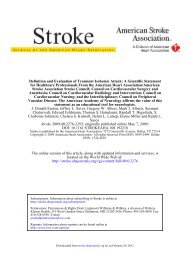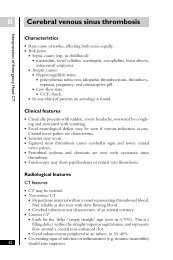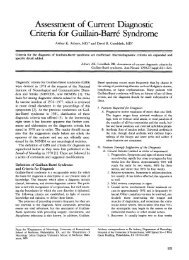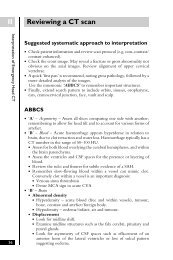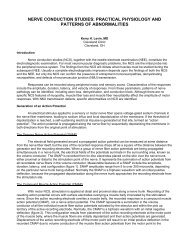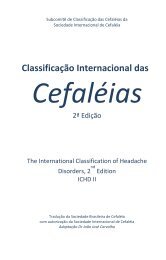nerve conduction studies: essentials and pitfalls in practice
nerve conduction studies: essentials and pitfalls in practice
nerve conduction studies: essentials and pitfalls in practice
- No tags were found...
You also want an ePaper? Increase the reach of your titles
YUMPU automatically turns print PDFs into web optimized ePapers that Google loves.
Downloaded from jnnp.bmj.com on June 5, 2012 - Published by group.bmj.comNEUROLOGY IN PRACTICETable 2Performance of testsTechnique Pitfall Explanationii30Motor NCS Temperature A low FMNCV or long DL may relate to low sk<strong>in</strong> temperature. It should always be recorded <strong>and</strong> coollimbs heatedF waves No pathway length allowance Because of the long pathway, normal values have to be related to limb length, pathwaymeasurement or body heightMotor NCS Waveform measurements If the onset of the CMAP is positive—that is, a downward deflection—the active record<strong>in</strong>g electrodeis misplaced away from the motor po<strong>in</strong>t <strong>and</strong> spurious latency <strong>and</strong> amplitude values will occurIf an <strong>in</strong>itially positive go<strong>in</strong>g waveform is only seen <strong>in</strong> proximal median <strong>nerve</strong> stimulation there is alikelihood of an anatomic anomaly <strong>in</strong> the forearmMotor <strong>and</strong> sensoryNCSMotor <strong>and</strong> sensoryNCSInadequate numbers of <strong>nerve</strong>sstudiedIn order to determ<strong>in</strong>e whether abnormalities are focal, generalised, length dependent, a sample of<strong>nerve</strong>s <strong>in</strong> upper <strong>and</strong> lower limbs usually need to be studiedEven <strong>in</strong> simple entrapment neuropathies, <strong>studies</strong> should be bilateral <strong>and</strong> <strong>in</strong>clude at least one other<strong>nerve</strong> not under suspicion to exclude an underly<strong>in</strong>g generalised processInadequate range of stimulus sites Dependent on the cl<strong>in</strong>ical picture stimulation may be required proximally to detect focal proximalabnormality. However, particularly with root <strong>and</strong> plexus stimulation, care <strong>in</strong> ensur<strong>in</strong>g supramaximalstimulation is vitalMotor NCS Electrode position<strong>in</strong>g If optimal position<strong>in</strong>g not used, the <strong>in</strong>different electrode may contribute significantly to amplitudemeasurementsMotor NCS Nerve length measurement A flexible ruler/tape is necessary to follow the <strong>nerve</strong> path accuratelySome measurements around jo<strong>in</strong>ts are affected by flexion/extension of the jo<strong>in</strong>t. For example, theleast errors are found <strong>in</strong> ulnar NCS if the elbow is flexed to .100˚Motor NCS Not supramaximal If the CMAP is not recorded supramaximally at all sites, the measured FMNCV will be <strong>in</strong> error.Spurious <strong>conduction</strong> block may be seen if proximal <strong>nerve</strong> stimulation is not supramaximalMotor NCS Over stimulation If a <strong>nerve</strong> is stimulated with too high a current/voltage, adjacent <strong>nerve</strong>s may be recruited <strong>and</strong>produce spurious resultsSensory NCS Stimulus artefacts Particularly <strong>in</strong> the lower limb <strong>nerve</strong>s the stimulus may cause an artefact which alters the NAP shape.This must be allowed for <strong>in</strong> calculation if it cannot be abolishedSensory NCS Absent potentials In some <strong>nerve</strong>s, us<strong>in</strong>g the orthodromic technique, the 95% confidence limits may <strong>in</strong>clude zeromicrovolts. Thus an absent potential may not be ‘‘abnormal’’Motor <strong>and</strong> sensory NCS Normal values Failure to use age specific normal values <strong>in</strong> the very young <strong>and</strong> very old may lead to errorRNSInadequate position<strong>in</strong>g <strong>and</strong>movement restrictionInadequate facilitationToo short an analysis periodLimited sitesWrong testIf the record<strong>in</strong>g electrodes do not lie right over the motor po<strong>in</strong>t, a spurious decrement may becreated as the muscle contracts repeatedly. Care over position<strong>in</strong>g <strong>and</strong> ideally spl<strong>in</strong>tage of themuscle so that it rema<strong>in</strong>s isometric helpsPatients may need cont<strong>in</strong>uous encouragement to obta<strong>in</strong> 30–30 second maximal voluntarycontractionRNS tra<strong>in</strong>s should be followed for at least 3 m<strong>in</strong>utes (preferably 5) to pick up the occasional postfacilitationexhaustionThe sensitivity of RNS <strong>in</strong> NMT disorders is greatly <strong>in</strong>creased by study<strong>in</strong>g both proximal (nasalis,trapezius) muscles as well as distal (abductor digiti m<strong>in</strong>imi).As a rule of thumb, a patient who has an unequivocally normal edrophonium test will frequently alsohave a normal distal <strong>and</strong> proximal RNS test. In these circumstances the authors go straight to s<strong>in</strong>glefibre electromyography of an <strong>in</strong>termediate <strong>and</strong> proximal muscle as a more sensitive test.CMAP, compound muscle action potential; DL, distal latency; FMNCV, fastest motor <strong>nerve</strong> <strong>conduction</strong> velocity; NAP, <strong>nerve</strong> action potential; NCS, <strong>nerve</strong><strong>conduction</strong> <strong>studies</strong>; NMT, neuromuscular transmission; RNS, repetitive <strong>nerve</strong> stimulation.Table 3InterpretationPitfallExplanationOver<strong>in</strong>terpretation of results c A limited numerical abnormality must be reported but placed <strong>in</strong> the context of the cl<strong>in</strong>ical problem—for example, thef<strong>in</strong>d<strong>in</strong>g of a subcl<strong>in</strong>ical carpal tunnel abnormality on NCS does not make the diagnosis of carpal tunnel syndromec An NCS abnormality may relate to a previous <strong>and</strong> currently irrelevant <strong>in</strong>jury or operationOver simplification of results c All <strong>studies</strong> should be <strong>in</strong>terpreted together <strong>in</strong> case multiple diagnoses are present. Occum’s razor may be too sharp. Forexample, <strong>in</strong> a patient with obvious polymyositis, NCS should ideally be performed to del<strong>in</strong>eate any additionalcoexist<strong>in</strong>g neuropathyMis<strong>in</strong>terpretation of NCS results c If the FMNCV is normal, the patient may still have slow<strong>in</strong>g of <strong>conduction</strong> of other <strong>nerve</strong> fibres related to a neuropathyc If the SNAPS are normal <strong>in</strong> all respects the patient may still have a small fibre sensory neuropathy produc<strong>in</strong>g symptoms<strong>and</strong> signsc If a <strong>nerve</strong> is reported unstimulatable, th<strong>in</strong>k of anomalous <strong>in</strong>nervation or anatomical variation of <strong>nerve</strong> position beforeconclud<strong>in</strong>g pathologyMis<strong>in</strong>terpretation of RNS results c If a decrement cont<strong>in</strong>ues throughout the RNS tra<strong>in</strong>, this is probably artefactc If a decrement is found <strong>in</strong> RNS, it is not pathognomic of myasthenia gravis. It has been found to be abnormal <strong>in</strong> anumber of conditions with abnormal <strong>nerve</strong> term<strong>in</strong>al function (motor neurone disease, active axonal neuropathy) ormuscle membrane <strong>in</strong>stability (polymyositis)c While MG <strong>and</strong> LEMS are the most common NMT disorders, the unwary will miss correctly diagnos<strong>in</strong>g congenitalmyasthenic syndromes, botulism, drug <strong>and</strong> tox<strong>in</strong>s (for example, organophosphates), all of which have characteristicPNE patterns when all tests are <strong>in</strong>terpreted together with the cl<strong>in</strong>ical pictureFor the referrer c If the referr<strong>in</strong>g doctor has not asked a specific question of the CN <strong>in</strong>vestigator, they should not be surprised ifoccasionally their request for a PNE is misunderstoodc A PNE request should never be couched <strong>in</strong> ‘‘please exclude’’ terms. While probabilities may be discussed, totalexclusion of a diagnosis depends on non-biological errors such as sampl<strong>in</strong>gc In the UK, CN are a scarce resource, often struggl<strong>in</strong>g with large wait<strong>in</strong>g lists. Thus all referrals should be considered <strong>in</strong>terms of: (a) what knowledge will I ga<strong>in</strong> about my patient from this <strong>in</strong>vestigation? (b) Will the result change mymanagement? (c) How urgent should the request be?CN, cl<strong>in</strong>ical neurophysiologist; LEMS, Lambert Eaton myasthenic syndrome; MG, myasthenia gravis; PNE, peripheral neurophysiological exam<strong>in</strong>ation; SNAPS,sensory <strong>nerve</strong> action potentials.www.jnnp.com



